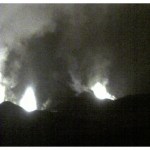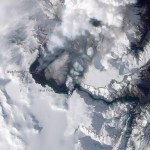basaltic eruption
Dark ash covers an American Airline 737 on the tarmac at the airport in Guatemala City.
Two volcanoes are making headlines right now (and neither is in Iceland).
As I mentioned yesterday, Pacaya in Guatemala erupted (video) causing widespread disruption of life in the nearby Guatemala City and costing two people their lives (including a TV reporter who got too close to the vent). Almost 2,000 people have been evacuated from the region near the volcano. The BBC has posted some impressive video of the eruption of Pacaya, showing the strombolian explosions sending basaltic tephra high into the…
Brief news!
Lava flows reaching the sea at Kilauea in Hawai`i. Image from November 2009, courtesy of HVO/USGS.
The Alert Status at Cleveland in the Alaskan Aleutian Islands was raised to Yellow (Advisory) by the Alaska Volcano Observatory after new signs of activity emerged. The latest report from AVO on the volcano says a thermal anomaly has been spotted at the summit, which typically is one of the first signs that the volcano is entering an eruption period. However, there is no real-time seismic monitoring for Cleveland, so that is the only clue (right now) that AVO has. Cleveland is a…
The Eyjafjallajökull-Fimmvörduháls eruption on April 7, 2010.
Just as we were speculating that the Eyjafjallajökull-Fimmvörduháls eruption might be over, Icelandic officials may have ordered an evacuation for towns (icelandic) in the area (but information in english is scant). There have been a recent swarm of shallow earthquakes underneath the Eyjafjallajökull ice cap - and if there is any chance that this could be signs of a new eruption under the ice, evacuations are justified. This could mean a jökulhlaup could be generated. These glacial floods are highly destructive, so getting…
The Eyjafjallajökull-Fimmvörduháls eruption at night on April 10, 2010.
I mentioned this earlier in the Monday Musings column, but the Eyjafjallajökull-Fimmvörduháls eruption in Iceland that started last month seems to be at a nadir of activity since its inception. This is being interpreted by the Icelandic Met Office as a sign that the eruption itself may be winding down after less than a month of activity - the earthquakes and inflation associated with the eruption appears to be subsiding along with the actual eruptive activity. Now, there is always the chance that the fissure will…
The eruption at Eyjafjallajökull-Fimmvörduháls continues on - the explosive spatter and bomb eruptions at the new central vent (on the second fissure) were impressive all night, making the hikers/cars/aircraft look like mites in comparison. This eruption has, so far, followed the pattern of Hawaiian-style volcanism quite well, so I thought it could be a good time to talk about what exactly Hawaiian-style volcanism is. There is a sequence of events that leads up to and follows the start of an Hawaiian-style eruption - although this sequence can stop at any point along the way - but it is…
Quick hits for a Monday morning (however, the week did have a good start).
Lava fountaining on March 27, 2010 at the Eyjafjallajokull-Fimmvörduháls eruption in Iceland.
The Eyjafjallajokull-Fimmvörduháls eruption is still going strong with two active fissure - and a lot of tourists poking around as well. If you watch the webcams closely, you can even see the cars and hikers trekking up near the erupting basaltic fissure (except today, as there seems to be a blizzard). Not to say that people are getting a little, well, nonchalant, but there is a story of serving meals cooked on lava up…
Sunny and 80 here in Ohio today. That could mean only one thing that is likely on everyone's mind. (I suppose there is also this other bit of news that we've been following, too.)
The low, broad shield of Hawai`i's Mauna Loa volcano.
The USGS announced yesterday that inflation at Hawai`i's Mauna Loa appears to have ceased. This prompted the decision to move the alert status at Mauna Loa from "Advisory" to "Normal". This would signify the end of any current activity on the big island's largest volcano - the inflation that had been slowing since 2006 (since 2003 really) finally stopped in…
Superfast entry as I run out the door but ...
The new vent that opened on March 31 at Fimmvörðuhálsi in Iceland. The old vent is to the right in the image and new to the left. Image captured at 5:45PM EDT.
A second fissure has opened at the Fimmvörðuhálsi eruption in Iceland. Check out the webcam and you can clearly see a new set of vents (Icelandic - try Google Translate) on the left hand side of the image - and that wasn't there earlier today. You can see an image of the new vents here.
Thank you to all the Eruptions readers who have been keeping us posted!
Busy busy today, so just a brief update on the ongoing Fimmvörðuháls/Eyjafjallajokull eruption in Iceland.
The coalesced vent of the Fimmvörðuháls fissure eruption in late March 2010.
The eruption is still going, albeit potentially with a little less vigor than before - and you can watch it on the Vodafone webcam, along with these other webcams from Mila.is. Haraldur Sigurdsson says that the eruption may have peaked (Icelandic) and is ~25% less vigorous than it was a few days ago, but this could change without notice. A fairly significant, long, low scoria cone has formed and lava…
Alright, I'm actually in Wisconsin right now for a wedding, but this was too cool to pass up ... the folks from the NASA Earth Observatory sent me this image (Natural-color, 10m/pixel) from the Advanced Land Imager aboard EO-1 of the Eyjafjallajokull-Fimmvörduháls eruption, both taken on March 24, 2010.
The Fimmvörduháls eruption in Iceland, taken March 24, 2010. Image courtesy of the NASA Earth Observatory. Click on the image for a larger version.
You can clearly see the flow heading down the drainage to the east, slowly snaking down the snow covered area. I think the steam plume on far…
The fissure vent eruption near Eyjafjallajokull in Iceland. Image by Ãorsteinn Gunnarsson, March 22, 2010.
It has been hard to keep up with the flood of news from the Eyjafjallajokull eruption in Iceland. Eruptions readers have done a good job with getting new images, videos and info up as they happen, so you might want to peruse the comments for those sorts of tidbits (along with discussion of what might be happening).
Here is the latest:
The eruption at Fimmvörduháls (considering the eruption is actually occurring between the ice caps) could last weeks to months, which isn't too…
The fissure vent eruption on Eyjafjallajokull in Iceland on March 21, 2010.
The big news this morning is the eruption that started last night at Eyjafjallajokull in Iceland, producing a 1-km fissure vent. The pictures and videos I've seen so far have been quite impressive, with the classic look of a "curtain of fire", where basaltic lava erupts explosively from a linear array of vents - you can see the geometry in the image from the BBC/AP (above). Especially clear is the dual nature of the eruption, with both the explosive fire fountains and the effusive (passive) lava flows from the root…
The latest in my Volcano Profiles series, this one on Erta Ale in Ethiopia.
The summit crater at Erta Ale in 1994
Location: The Afar region of Ethiopia.
Height: 613 m / 2,011 feet
Tectonic setting: Erta Ale (meaning "smoking mountain") is part of the East African Rift, where the African Continent is tearing apart along a seam that runs from the Red Sea/Gulf of Aden (two other arms of the rift themselves) south through eastern Africa. Many of the large lakes of eastern Africa such as Lakes Albert, Tanganyika, Nyasa and Kariba fill rift valleys created by the cracking of the continental plate…
Did I mention its a busy week?
The lava lake at Erta'Ale in 2008. Image courtesy of Stromboli Online.
Our Icelandic saga continues, with more earthquakes and more speculation/information on the parts of Eruptions readers. Keep up the discussion - I'll be fascinated to see who turns out to get closest to what actually happens, prediction-wise. The seismicity has quieted somewhat again in the last 12 hours, so we wait eagerly to see what comes next. Remember, Iceland is the land where volcanoes helped change history, so it is always fun to talk Icelandic volcanism.
The NASA Earth Observatory…
The Icelandic coast of Reykjanes where the Mid-Atlantic Ridge comes above sea level.
A number of Eruptions readers have noticed that seismicity along the Reykjanes Ridge that runs to the southwest of Iceland onto the island has increased over the last few days. Sure enough, checking the Icelandic Met Office page on seismicity on the island finds a lot of earthquakes on the southwest peninsula that is the manifestation of the Mid-Atlantic Ridge hitting the hotspot-related Icelandic landmass. The interaction between the Iceland plume and the Mid-Atlantic Ridge is complex, with a step in the…
News for the snowy (well, here) midweek:
Lava flows from Kilauea surround an old structure at Royal Gardens in Hawai`i.
A hearty thanks to all the Eruptions readers who offered advice on where to find a couple of great volcano videos I've been trying to track down. I think I've found copies I can get a hold of at the USGS and discovered that Discover Your Northwest (formerly the NW Interpretative Assoc.) is expecting to get a DVD version of one of the videos this spring.
The folks at the Astronomy Picture of the Day put up this great image of strombolian eruptions and lightning at…
Some news for the last Friday in January:
Volcanic lightning captured over Redoubt in March 2009.
Tungurahua in Ecuador continues to erupt. Yesterday, the volcano spread ash over much of central Ecuador. Apparently people in Ecuador aren't taking the hazard of ash too seriously, with many ignoring recommendations to wear masks when the ash is falling. Over 50 explosions have been recorded over the last 24 hours at the volcano according to the Ecuadorian Instituto GeofÃsico, most of them small to moderate.
We also have a new USGS/Smithsonian Institute Volcano Activity Report. Much of the "…
The collapse pit within the Halema`uma`u Crater at Kilauea taken January 7, 2010. Image courtesy of the USGS/HVO.
Eruptions reader Boris Behncke pointed out that things are afoot in the Halema`uma`u Crater at Kilauea. To steal his description: " the lava lake returned triumphantly to the active pit last night, and now it is filling virtually the entire field of the
Halema'uma'u Overlook webcam." Sure enough, checking out the webcam this morning, the field of view is dominated by a lava lake - albeit somewhat crusted over by hardened basalt lava. You can compare the current image with one…
It didn't take long in the new year to get started!
Nymuragira erupting in January 2010.
Nyamuragira in the Congo erupted to start off the new year, producing explosions and lava flows. The flow are moving down the southern flank of the volcano. The eruption started with loud, concussive noises at 3:45 AM that startled rangers at the National Park that surround the volcanoes Nyamuragira and Nyiragongo. It appears that there was some part of the eruption that was either fire fountains or strombolian as the rangers describe the early events as "fire with sparks flying". The lava flows from…
Here it is, my attempt to recap a year's worth of volcanic events. By no means is this supposed to capture every event, but rather the highlight/lowlights and what most captivated me during 2009. I'll be announcing the winner of the 2009 Pliny for Volcanic Event of the Year tomorrow.
Waimangu Geothermal Valley in New Zealand, taken in January 2009 by Erik Klemetti.
January
The year started out with a trip to New Zealand (well, for me at least) and vistas of the Waimangu Valley, formed in the 1886 eruption of Tarawera on the North Island. We were also still thinking about the late 2008…

